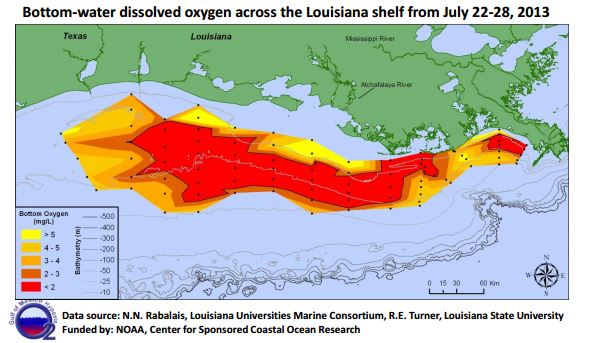Reported by Robert McClure, InvestigateWest
Waterways across the country are beset by a disturbing pattern: Polluted water discharged from sewage treatment plants carries with it vast amounts of phosphorus and nitrogen, which are known as “nutrients.” The nutrients feed massive algae blooms. Those in turn spur the growth of microbes -- teeny-tiny bugs -- that suck out of the water the oxygen that’s needed by fish and other aquatic creatures.  The result is aquatic “dead zones” like the one off the coast of Louisiana, where the Mississippi River flows into the Gulf of Mexico. At its peak last year, that lifeless oceanic zone reached the size of Connecticut. While scientists and engineers nationwide grapple with the problem, one persistent environmental engineer in Salt Lake City has been pointing out for three decades what appears to be a major failing of pollution tests performed at sewage-treatment plants across the country. If he is right, they are a major unrecognized contributor to the problem. To put it simply, Peter Maier maintains that current testing procedures account for the nutrients from humans’ solid waste, but not from nutrients in urine. The problem traces to the way waste is tested for “biochemical oxygen demand,” or BOD. So how did this come to pass? After the federal Clean Water Act was passed in 1972, about two-thirds of sewage-treatment plants were continually failing the required tests. The U.S. Environmental Protection Agency (EPA) then changed the tests. It eliminated the need to measure the amount of “biochemical oxygen demand” from nitrogen-based wastes -- pee -- while retaining the need to measure the same from carbon-based wastes -- poop. The reason? It takes 30 days or so to measure the effects of the pee, but 10 days or less for the poop. Here’s how we explained it in an award-winning seriesby InvestigateWest and EarthFix titled “Clean Water: The Next Act.”
The result is aquatic “dead zones” like the one off the coast of Louisiana, where the Mississippi River flows into the Gulf of Mexico. At its peak last year, that lifeless oceanic zone reached the size of Connecticut. While scientists and engineers nationwide grapple with the problem, one persistent environmental engineer in Salt Lake City has been pointing out for three decades what appears to be a major failing of pollution tests performed at sewage-treatment plants across the country. If he is right, they are a major unrecognized contributor to the problem. To put it simply, Peter Maier maintains that current testing procedures account for the nutrients from humans’ solid waste, but not from nutrients in urine. The problem traces to the way waste is tested for “biochemical oxygen demand,” or BOD. So how did this come to pass? After the federal Clean Water Act was passed in 1972, about two-thirds of sewage-treatment plants were continually failing the required tests. The U.S. Environmental Protection Agency (EPA) then changed the tests. It eliminated the need to measure the amount of “biochemical oxygen demand” from nitrogen-based wastes -- pee -- while retaining the need to measure the same from carbon-based wastes -- poop. The reason? It takes 30 days or so to measure the effects of the pee, but 10 days or less for the poop. Here’s how we explained it in an award-winning seriesby InvestigateWest and EarthFix titled “Clean Water: The Next Act.”
“The carbon-eating microbes are in full swing by the fifth day of the test. Their populations are thriving. But the nitrogen-eating bugs are just getting started, and may not get up to full speed until maybe the sixth to the eighth day, depending on conditions such as the temperature. (They do better in warmer weather.) It can take up to 30 days for those bugs to digest the urine-based waste. And this is where the science of sewage treatment parts ways with the actual methods used in the U.S., as Maier sees it… . The problem, Maier says, is that those nitrogen-eating bugs that die in the laboratory flask don’t get killed in the actual sewage-treatment plants. And those nitrogen-eating bugs keep on eating waste and requiring oxygen that comes out of the streams where the waste is dumped -- at the expense of the fish and other aquatic creatures that live there. Plus, all the nitrogen that the bacteria haven’t eaten acts as a fertilizer for algae downstream from the sewage plant.”
So right now Maier contends that there are numerous examples of water bodies where sewage-treatment plants are meeting their official pollution-control limits, but are in fact continuing to contribute to the downturn in water quality.

Maier has sued the EPA and testified before Congress to get the word out -- to little avail. Now his contentions are getting new currency as environmentalists push several suits against the EPA, including one that blames the agency for not controlling the nutrients in the Mississippi River basin that killed off part of the Gulf of Mexico. One reason Maier hasn’t gotten farther may be his cantankerous nature, friends say, and it also doesn’t help that he still has a thick accent from his upbringing in the Netherlands. Said ally Lowell Palm, a mechanical engineer, “Some of it’s Peter’s ‘foreign-ness’ and rather abrasive approach to those who might hold opinions different from his. And I think that caused a lot of tension.” Fortunately for Maier’s cause, the issue of nutrients is front and center in a case brought by environmentalists in federal court in New Orleans. The suit accuses the EPA of dereliction of duty for failing to control nutrient pollution that causes the Gulf of Mexico dead zone. A judge ordered the agency to respond by March 19 as to why, but the EPA won a last-minute stayfrom an appeals court.
